Intel Core i7 3960X (Sandy Bridge E) Review: Keeping the High End Alive
by Anand Lal Shimpi on November 14, 2011 3:01 AM EST- Posted in
- CPUs
- Intel
- Core i7
- Sandy Bridge
- Sandy Bridge E
Windows 7 Application Performance
3dsmax 9
Today's desktop processors are more than fast enough to do professional level 3D rendering at home. To look at performance under 3dsmax we ran the SPECapc 3dsmax 8 benchmark (only the CPU rendering tests) under 3dsmax 9 SP1. The results reported are the rendering composite scores.
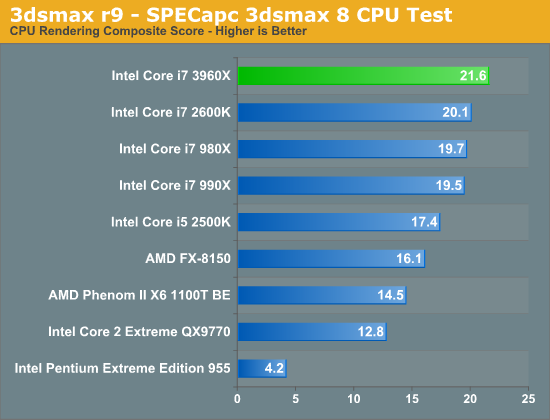
Offline 3D rendering applications make some of the best use of CPU cores, unfortunately our test here doesn't scale all that well. We only see a 7% increase over the 2600K. If we look at a more modern 3D workload however...
Cinebench 11.5
Created by the Cinema 4D folks we have Cinebench, a popular 3D rendering benchmark that gives us both single and multi-threaded 3D rendering results.
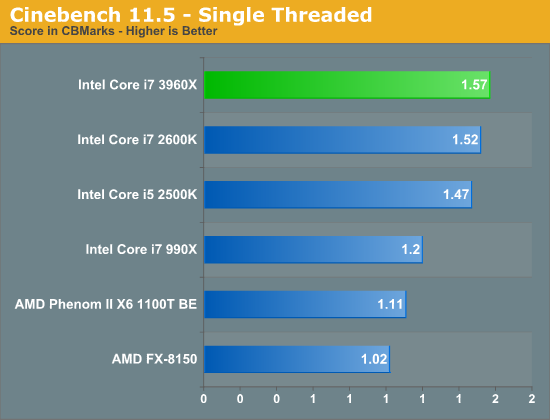
Single threaded performance is marginally better than the 2600K thanks to the 3960X's slightly higher max turbo speed. What's more important than the performance here is the fact that the 3960X is able to properly power gate all idle cores and give a single core full reign of the chip's TDP. Turbo is alive and well in SNB-E, just as it was in Sandy Bridge.
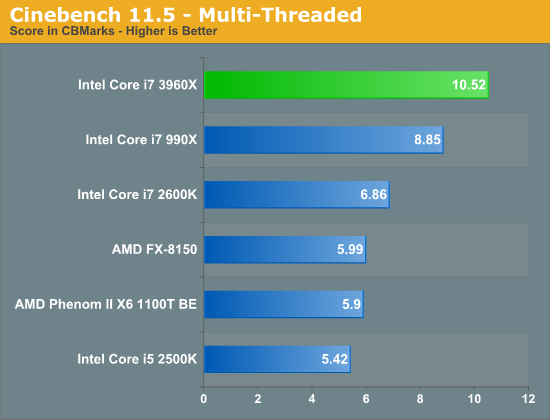
Here the performance gains are staggering. The 3960X is 53% faster than the 2600K and 19% faster than Intel's previous 6-core flagship, the 990X. The Bulldozer comparison is almost unfair, the 3960X is 75% faster (granted it is also multiple times the price of the FX-8150).
7-Zip Benchmark
While Cinebench shows us multithreaded floating point performance, the 7-zip benchmark gives us an indication of multithreaded integer performance:

Here we see huge gains over the 2600K (58%), indicating that the increase in cache size and memory bandwidth help the boost in core count a bit here. The advantage over the 990X is only 7%. This gives us a bit of a preview of what we can expect from SNB-EP Xeon server performance.
PAR2 Benchmark
Par2 is an application used for reconstructing downloaded archives. It can generate parity data from a given archive and later use it to recover the archive
Chuchusoft took the source code of par2cmdline 0.4 and parallelized it using Intel’s Threading Building Blocks 2.1. The result is a version of par2cmdline that can spawn multiple threads to repair par2 archives. For this test we took a 708MB archive, corrupted nearly 60MB of it, and used the multithreaded par2cmdline to recover it. The scores reported are the repair and recover time in seconds.
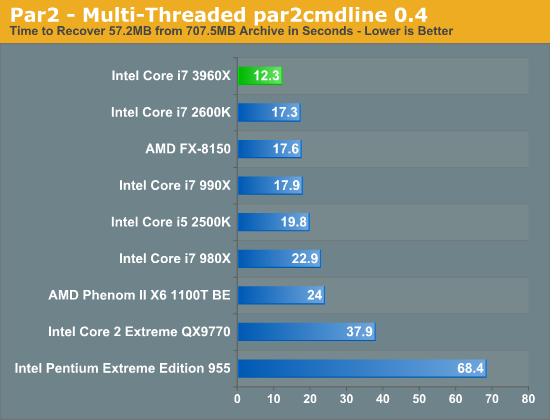
Here we see a 40% increase in performance over the 2600K and FX-8150.
TrueCrypt Benchmark
TrueCrypt is a very popular encryption package that offers full AES-NI support. The application also features a built-in encryption benchmark that we can use to measure CPU performance with:
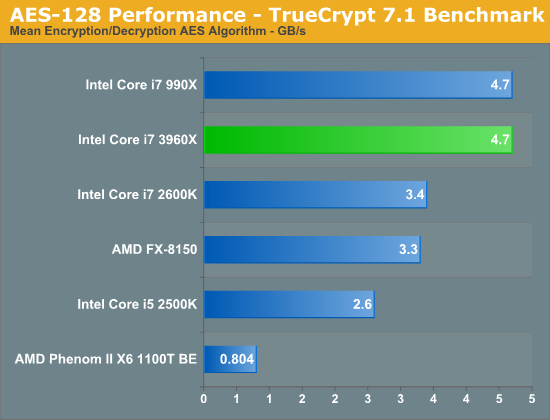
As both the 990X and 3960X have AES-NI support, both are equally capable at cranking through an AES workload. Per core performance doesn't appear to have changed all that much with the move to Sandy Bridge, so here we have a situation where the 3960X is much faster than the 2600K but no faster than the 990X. I suspect these types of scenarios will be fairly rare.
x264 HD 3.03 Benchmark
Graysky's x264 HD test uses x264 to encode a 4Mbps 720p MPEG-2 source. The focus here is on quality rather than speed, thus the benchmark uses a 2-pass encode and reports the average frame rate in each pass.
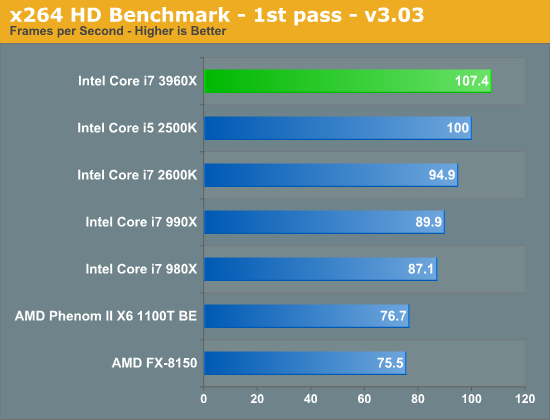
Single threaded performance isn't significantly faster than your run-of-the-mill Sandy Bridge, which means the first x264 HD pass doesn't look all that impressive on SNB-E.
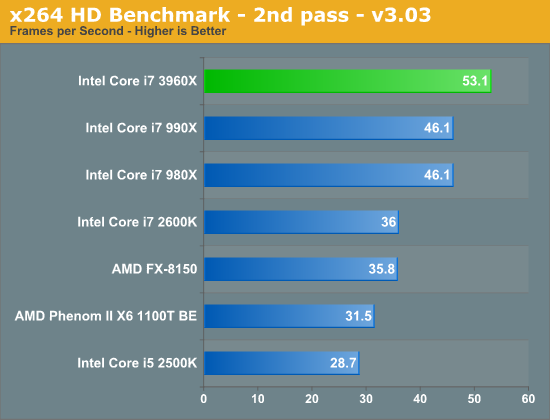
The second pass however stresses all six cores far more readily, resulting in a 47.5% increase in performance over the 2600K. Even compared to the 990X there's a 15% increase in performance.
Adobe Photoshop CS4
To measure performance under Photoshop CS4 we turn to the Retouch Artists’ Speed Test. The test does basic photo editing; there are a couple of color space conversions, many layer creations, color curve adjustment, image and canvas size adjustment, unsharp mask, and finally a gaussian blur performed on the entire image.
The whole process is timed and thanks to the use of Intel's X25-M SSD as our test bed hard drive, performance is far more predictable than back when we used to test on mechanical disks.
Time is reported in seconds and the lower numbers mean better performance. The test is multithreaded and can hit all four cores in a quad-core machine.
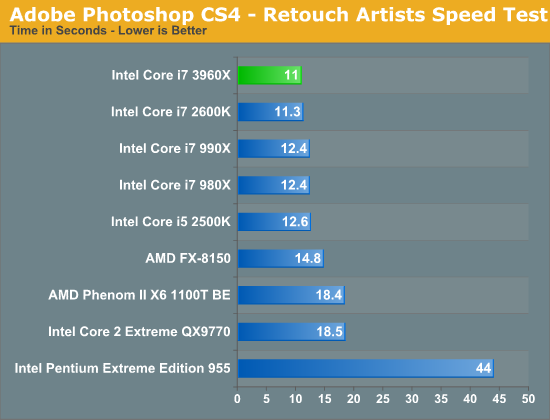
Our Photoshop test is multithreaded but there are only spikes that use more than four cores. That combined with the short duration of the benchmark shows no real advantage to the 3960X over the 2600K. Sandy Bridge E is faster than Intel's old 6-core solution though.
Compile Chromium Test
You guys asked for it and finally I have something I feel is a good software build test. Using Visual Studio 2008 I'm compiling Chromium. It's a pretty huge project that takes over forty minutes to compile from the command line on the Core i3 2100. But the results are repeatable and the compile process will stress all 12 threads at 100% for almost the entire time on a 980X so it works for me.
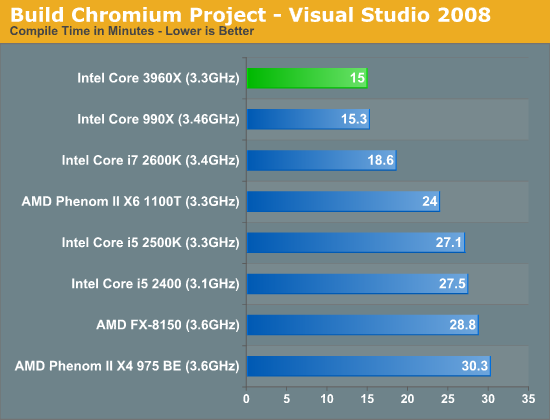
Our compile test is extremely well threaded, which once again does well on the 3960X. The gains aren't as big as what we saw in some of our earlier 3D/transcoding tests, but if you're looking to build the fastest development workstation you'll want a Sandy Bridge E.
Excel Monte Carlo
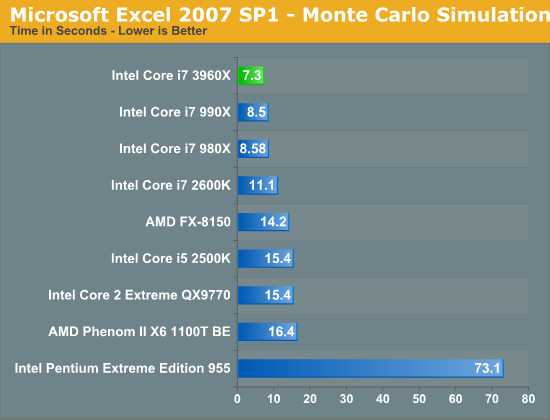
Multithreaded compute does well on SNB-E regardless of the type of application. Excel is multithreaded and if you have a beefy enough workload, you'll see huge gains over the 2600K.










163 Comments
View All Comments
Valitri - Wednesday, November 16, 2011 - link
Good review as always.Turns out to be slightly less than I was expecting. The performance "jump" from an 1155 SB just isn't there for generic enthusiasts and gamers. Perhaps encoders, renderers, and mathmaticians will enjoy the performance but it doesn't do much for me. Makes me very happy I stepped to a 2500k and I look forward to Ivy Bridge early next year.
Gonemad - Wednesday, November 16, 2011 - link
If there are 16GB DIMMs, and this sucker has 8 DIMMs sockets... 128GB in a home system... hmmm. It makes SSDs all the less appealing. (Specially because you just blew lots of money in DIMM memory, but still...). Pop in a Ramdrive, wait 5 minutes to boot... don't wait anymore. I can see some specific usage that could benefit of this kind of storage subsystem speed. Even if it is a 'tiny' 64GB ramdrive.It may not entirely replace a small SSD, but you can do some neat tricks with that kind of RAM at home. I know only one module is many times more expensive than a SSD, but just the fact that you can do it is remarkable.
Too bad this chip costs a lot, and IT. IS. HUGE. The thing has the size of a cup-holder, or at least the socket. With that amount of die you could build 2 * i7- 2600k and with the amount of money you blow on one, you can still pay for 3 * i7s.
Oh yes, check for yourselves. That's your premium profit margin right there.
This sucker has 435mm2 while the Sandy Bridge 4c has 216mm2. Twice more!
This behemoth will nick your pockets in $999, when a i7-2600k cuts you $317.
Nearly 3 times more. More than 3 times in fact. It is almost pi() times more. Wait, it is pi times more expensive, up to the third decimal. Hmm. I bet you are paying for the lost wafer too. Or it is just a wild coincidence. It doesn't perform twice as better, only 50% better, in some benchies. And it is so big that you can almost call it a TILE, not a CHIP. I am betting that on the same die you build 3 * 2600k, you can build only 2 of these and lose the difference. It should squash the competition. It is a bomb.
Some chip.
Diminishing returns indeed.
Wolfpup - Wednesday, November 16, 2011 - link
"All of this growth in die area comes at the expense of one of Sandy Bridge's greatest assets: its integrated graphics core"Whaaaaat? Greatest assets? It's a waste of space. It should be used for more cache or another core or whatever on the quad version. I can't believe this site...Anandtech of all places...has ANYTHING positive to say about integrated graphics!~
noeldillabough - Wednesday, November 16, 2011 - link
For laptops the integrated graphics is AWESOME however on my gaming machine with top end graphics cards eating space for integrated graphics seems silly.jmelgaard - Thursday, November 17, 2011 - link
The fact that you still talk about X number of cores shows you haven't understood my posts.Your thinking: "How many cores can I make my game utilize"
My model: "How many small enough jobs of processing can I split my game up into"
Number of cores have no relevance in modern architectures, while in a Game engine you properly wan't to take control over the execution of those jobs, priority jobs etc.
The funny thing is, your BF3 already runs on 500+ cores when it comes to the rendering, lighting, polygon transformations and so on... All by chopping the big job of rendering a screen into little bits of work... just like i suggest you can do with the rest of a game, just like we do with so many other applications today.
"I doubt it. There's a reason why game engines are modified as they get older."
Almost every single corp only sees ahead to the next budget year...
seapeople - Saturday, November 19, 2011 - link
Of course it's inevitable you would resort to personal attacks and profanity in an argument you are losing.It's a different mindset... do you think graphics work is programmed by thinking "Ok, today's GPU's have 500 cores, so let's optimize our game to use exactly 500 threads..."
abhicherath - Sunday, November 20, 2011 - link
Why?Why are those 2 fused off....seriously for a 1000 buck CPU, you don't expect intel to hold stuff back....gosh, this is competition crap. If AMD's bulldozers were powerful as hell and outperformed the i7's i sure as hell expect that those 2 cores would be active....what's your opinion?
jmelgaard - Sunday, November 20, 2011 - link
"This doesn't involve a diatribe about number of cores in modern architectures."What what?... Do you even know what you are writing anymore?
What I am talking about is software architecture, which is highly relevant to the discussion.
Flerp - Sunday, November 20, 2011 - link
Even though there are very healthy gains in specific areas, I find the Sandy E to be a bit underwhelming, especially compared to how badly the X58 slaughtered the 775 platforms when it made its debut. I guess I'll be holding on to my X58 platform for another year or so and see what kind of improvements Ivy will bring.jmelgaard - Monday, November 21, 2011 - link
@rarsonThe whole reason I begin to talk about software architectures is because you are so hell-bend on sticking to your idea of "optimizing to a number of cores", I had to have you realize that you need to let go of that idea, your refusal to do so only makes me hope that you don't actually work with software development. No offence intended, because I would never be fit building a house either, it's not my field.
If you had ever gotten to understand that, the next discussion would be if it was beneficial to adopt this strategy within games, if it was viable and if it had a ROI that was worth pursuing if you could choose outside the bounds of this years budget, would it be an architecture that might cost us 2 to 3 times to pursue now, but saved us 20% development costs on our next games or engines for the next 10 years.
Of-course this could be a swing-and-miss if someone revolutionized how we look at our processors, much like they have done with GPU's, but as we have "barely" entered the multi-core-cpu-era, I don't expect this to happen within the next 10 years.
However that is all irrelevant because 10 years is not the time-frame, it is not even 5 or 3... the time-frame is a year at a time, and the cheapest solution in the time-frame of this years budget, that's the chosen one, that's the reason you are looking for, that is why they do it. And this is how almost, if not all, stock-based corporation operates. Why?... Because they have to satisfy stockholders... There is no other reason or rationalizations behind it.
DICE it self is not a stock-based company, but it is a fully owned by Electronic Arts, which is. And so EA's financial numbers is directly impacted by DICE as it counts towards EA's assets (not necessarily Revenue though).
With that, I am done with you, your best argument seems to be "They did it, so that must be the right thing to do"... When was anyone's choice ever evidence of it being the best one?